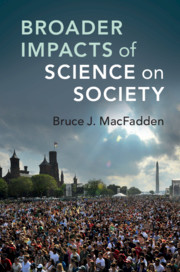Refine listing
Actions for selected content:
861 results in Ebooks for the Good Student

Broader Impacts of Science on Society
-
- Published online:
- 11 October 2019
- Print publication:
- 03 October 2019
Copyright page
-
- Book:
- Broader Impacts of Science on Society
- Published online:
- 11 October 2019
- Print publication:
- 03 October 2019, pp iv-iv
-
- Chapter
- Export citation
16 - Developing a Broader Impacts Plan
-
- Book:
- Broader Impacts of Science on Society
- Published online:
- 11 October 2019
- Print publication:
- 03 October 2019, pp 210-223
-
- Chapter
- Export citation
Index
-
- Book:
- Broader Impacts of Science on Society
- Published online:
- 11 October 2019
- Print publication:
- 03 October 2019, pp 290-304
-
- Chapter
- Export citation
5 - Promoting Yourself and Optimizing Impact
-
- Book:
- Broader Impacts of Science on Society
- Published online:
- 11 October 2019
- Print publication:
- 03 October 2019, pp 57-67
-
- Chapter
- Export citation
19 - Wrap-Up, the Future, and Broader Impacts 3.0
-
- Book:
- Broader Impacts of Science on Society
- Published online:
- 11 October 2019
- Print publication:
- 03 October 2019, pp 249-258
-
- Chapter
- Export citation
3 - Innovation, Opportunity, and Integration
-
- Book:
- Broader Impacts of Science on Society
- Published online:
- 11 October 2019
- Print publication:
- 03 October 2019, pp 29-41
-
- Chapter
- Export citation
15 - Computers and Cyberimpacts
-
- Book:
- Broader Impacts of Science on Society
- Published online:
- 11 October 2019
- Print publication:
- 03 October 2019, pp 194-209
-
- Chapter
- Export citation
7 - Strategic versus Curiosity Science
-
- Book:
- Broader Impacts of Science on Society
- Published online:
- 11 October 2019
- Print publication:
- 03 October 2019, pp 81-92
-
- Chapter
- Export citation
Reviews
-
- Book:
- Broader Impacts of Science on Society
- Published online:
- 11 October 2019
- Print publication:
- 03 October 2019, pp ii-ii
-
- Chapter
- Export citation
6 - Collaboration, Authorship, and Networks
-
- Book:
- Broader Impacts of Science on Society
- Published online:
- 11 October 2019
- Print publication:
- 03 October 2019, pp 68-80
-
- Chapter
- Export citation
17 - Project Management and Sustainability
-
- Book:
- Broader Impacts of Science on Society
- Published online:
- 11 October 2019
- Print publication:
- 03 October 2019, pp 224-235
-
- Chapter
- Export citation
9 - Diversity, Equity, and Inclusion
-
- Book:
- Broader Impacts of Science on Society
- Published online:
- 11 October 2019
- Print publication:
- 03 October 2019, pp 107-120
-
- Chapter
- Export citation
14 - Public Participation and Community (Citizen) Science
-
- Book:
- Broader Impacts of Science on Society
- Published online:
- 11 October 2019
- Print publication:
- 03 October 2019, pp 178-193
-
- Chapter
- Export citation
13 - Informal STEM Learning in Museums and Beyond
-
- Book:
- Broader Impacts of Science on Society
- Published online:
- 11 October 2019
- Print publication:
- 03 October 2019, pp 159-177
-
- Chapter
- Export citation
11 - Formal K–12 Education and Partners
-
- Book:
- Broader Impacts of Science on Society
- Published online:
- 11 October 2019
- Print publication:
- 03 October 2019, pp 136-149
-
- Chapter
- Export citation
2 - NSF and Broader Impacts
-
- Book:
- Broader Impacts of Science on Society
- Published online:
- 11 October 2019
- Print publication:
- 03 October 2019, pp 16-28
-
- Chapter
- Export citation
8 - Know Your Audience
-
- Book:
- Broader Impacts of Science on Society
- Published online:
- 11 October 2019
- Print publication:
- 03 October 2019, pp 93-106
-
- Chapter
- Export citation
4 - Communication and Dissemination
-
- Book:
- Broader Impacts of Science on Society
- Published online:
- 11 October 2019
- Print publication:
- 03 October 2019, pp 42-56
-
- Chapter
- Export citation
References
-
- Book:
- Broader Impacts of Science on Society
- Published online:
- 11 October 2019
- Print publication:
- 03 October 2019, pp 259-289
-
- Chapter
- Export citation
